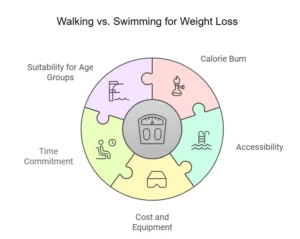Is Walking or Swimming Better for Weight Loss: Benefits, Comparison, and Tips for Women

Losing weight often starts with choosing the right exercise, but the decision can feel overwhelming with so many options. Among the most popular low-impact activities, walking and swimming are effective and accessible ways to shed pounds. This leads many to ask: Is walking or swimming better for weight loss?
Both exercises offer unique benefits, making the answer largely dependent on personal goals, preferences, and circumstances. Walking is easy, requires no equipment, and can be incorporated into your daily routine. On the other hand, swimming provides a full-body workout, burns more calories in less time, and is gentle on the joints.
This article explores the benefits of walking and swimming for weight loss. By comparing them across factors, such as calorie burn, accessibility, and health benefits, we aim to help you decide which is best for your weight loss journey.
Benefits of Walking for Weight Loss
Walking Helps You Lose Weight
Walking is a proven way to burn calories and lose weight. Research shows that walking at a moderate pace (3 mph) burns about 200-300 calories per hour, while brisk walking (4 mph) can burn up to 400 calories per hour, depending on your weight. It is a great option for beginners, helping to boost metabolism and promote fat loss with consistent exercise.
Additionally, walking improves heart health, increasing heart function and endurance. It also contributes to sustained weight loss by maintaining a calorie deficit with a balanced diet. Regular walking encourages the body to use fat stores for energy, making it an effective, low-impact fat-burning activity.
Accessibility and convenience
The biggest advantage of walking is its simplicity and accessibility. Unlike other forms of exercise, walking doesn’t require special equipment or facilities—all you need is a pair of comfortable shoes. It can be done anywhere, from parks to sidewalks, and it’s ideal for those with tight schedules.
Walking fits seamlessly into everyday routines, such as walking to work, climbing stairs, or walking your pet. This flexibility allows people to stay active without changing their lifestyles. For beginners, even a short 15-20 minute walk can be a stepping stone to building a lasting habit.
Low-impact nature
Walking is a low-impact exercise, making it suitable for people with joint problems, injuries, or those new to fitness. Compared to high-impact activities like running, walking is gentler on the knees, ankles, and back.
This feature makes walking a great choice for people of all fitness levels, including older adults or those recovering from physical injuries. It allows consistent movement without much exertion, promoting better joint mobility and overall health.
Mental and emotional benefits
Walking is good for the body and great for the mind. A study published in Environmental Science and Technology found that walking outdoors reduces stress and improves mood, thanks to fresh air and exposure to nature.
Walking can also promote social connections. Walking with friends, family, or groups creates bonding opportunities while staying active. The mental clarity and reduced stress associated with walking make it an enjoyable and sustainable exercise.
Benefits of Swimming for Weight Loss
Swimming Helps You Lose Weight
Swimming is a high-calorie exercise that engages multiple muscle groups at once. Depending on the stroke, swimming can burn between 400 and 700 calories per hour, with the butterfly stroke being the most intense and calorie-burning option (Mayo Clinic). It provides a full-body workout, targeting the muscles of the arms, legs, core, and back for balanced toning and weight loss.
Swimming also boosts metabolism and helps build lean muscle, further supporting long-term weight loss. The water resistance makes each move more challenging, increasing calorie expenditure and burning fat.
Low-impact but high-intensity exercise
Swimming is a low-impact activity that provides high-intensity results. It is ideal for people with joint pain, arthritis, or obesity, as the buoyancy of the water reduces stress on the joints while providing effective resistance training.
This makes swimming accessible to many people, including those who cannot do weight-bearing exercises such as running or strength training. Swimming is vigorous and can produce significant results consistently despite its low impact.
Relaxation and Stress Relief
Swimming has a meditative quality that helps reduce stress and anxiety. The rhythmic nature of swimming, combined with the calming effect of water, creates a calming experience that benefits mental health.
For many people, swimming becomes a time to disconnect from the stresses of everyday life and focus solely on movement and breathing. This relaxation, paired with the endorphins released during exercise, makes swimming a powerful tool for physical and emotional well-being.
Also, explore How to Meditate for Weight Loss.
Additional health benefits
In addition to weight loss, swimming offers a range of health benefits. It promotes cardiovascular health by improving heart function and increasing lung capacity, which is necessary for overall fitness.
Additionally, swimming promotes flexibility and core strength through the constant coordination and engagement of the entire body. Regular swimming can lower the risk of lifestyle-related illnesses like diabetes and high blood pressure and improve posture.
Walking vs. Swimming: A Weight Loss Comparison

Calorie Burn
Walking and swimming are effective calorie-burning exercises, but swimming burns more calories simultaneously. Body weight, speed, duration, and intensity can affect calories burned during both activities. Heavier individuals generally burn more calories due to the greater effort required. While walking intensity can be changed by adding inclines or changing speeds, swimming’s resistance-based nature enhances calorie expenditure.
Accessibility
Walking is highly accessible and does not require any special skills or equipment. It can be done almost anywhere, including parks, sidewalks, or treadmills, making it accessible to people of all fitness levels.
In contrast, swimming requires access to a pool or natural body of water and the ability to swim, which may not be possible for everyone. Swimming also has a steep learning curve for beginners, but it can be a great option for those who enjoy water-based activities.
Cost and Equipment
Walking is inexpensive, requiring little more than a good pair of shoes. Some walkers may choose to invest in fitness trackers or lightweight gear, but the overall cost remains minimal. Swimming, on the other hand, can be more expensive. Pool memberships, swimsuits, goggles, and optional gear such as swim caps or flotation devices can add to the cost. These costs can be reduced for individuals with access to a free-swimming location.
Time Commitment
Both walking and swimming can produce weight loss results, but swimming is more effective over a longer time due to the higher calorie burn per hour. Those with busy schedules may find swimming a faster option to achieve their fitness goals.
However, walking allows it to fit seamlessly into daily routines. A brisk 30-minute walk during your lunch break or commuting can add significant benefits over time. Both activities produce better results when done consistently.
Suitable for different age groups and fitness levels
Walking is more beginner-friendly and is suitable for people of all ages and fitness levels. It is especially ideal for older adults, those with limited fitness experience, or anyone recovering from injuries.
Swimming, while suitable for people with joint problems or joint pain, requires basic swimming ability. It is perfect for those comfortable in the water and looking for a higher-intensity workout. Swimming can also provide a fun and engaging alternative for those who enjoy water-based exercise.
Which is better for weight loss: Walking or Swimming?
Whether walking or swimming is better for weight loss depends on personal circumstances, preferences, and goals.
Walking is a great choice for beginners or those without access to a pool. It is easy to incorporate into everyday life and requires no special skills or equipment. Walking also works well for those who prefer outdoor activities or need a low-impact option for joint health.
Swimming is ideal for those seeking a high-intensity, full-body workout. It’s especially beneficial for those who suffer from joint pain or are obese, as it offers a low-impact but effective way to burn calories. Swimming can also be more enjoyable and stimulating for those who enjoy water-based activities.
Ultimately, both exercises are effective for weight loss, and the decision should be based on personal preference, lifestyle, and accessibility.
Practical Tips to Lose Weight
Tips for Effective Walking
- Alternate between slow and fast walking to burn calories and improve endurance.
- Walking uphill or on an incline treadmill increases intensity and burns more calories.
- Aim to walk at least 10,000 steps daily by walking to work, using the stairs, or taking active breaks.
Tips for Effective Swimming
- Experiment with strokes like freestyle, butterfly, or backstroke to target different muscle groups and increase calorie burn.
- Alternate between fast and slow laps to increase intensity and improve fitness.
- Make swimming a regular part of your weekly routine, doing at least 3-4 weekly sessions to see results.
Combine Walking and Swimming
Walking and swimming can provide the best of both worlds for those looking to lose as much weight as possible. Alternate between walking and swimming to create a balanced workout plan that avoids monotony.
For example, you could dedicate three days to swimming for total-body strength and cardio and two days to walking for accessibility and outdoor benefits. This combination keeps the workout engaging, ensures variety, and optimizes calorie burn and fat loss.
Walking Vs Swimming: Factors to Consider

Physical Health and Joint Conditions
Joint health and condition are important factors when choosing between swimming and walking. Walking is low-impact and gentle on the body, making it suitable for people with mild joint pain or those recovering from injuries. However, swimming is a better option for people with severe arthritis, obesity, or chronic pain. The rapid movement of the water reduces stress on the joints, allowing for an effective workout without discomfort.
Both activities can improve cardiovascular health and help with weight loss, but people with specific health concerns should consult their doctor before starting a new fitness regimen.
Lifestyle, Time Availability, and Preferences
Your lifestyle and time availability are important factors to consider. Walking is flexible and can be incorporated into daily routines, such as walking to work, jogging during lunch breaks, or walking the dog. This is a great option for those with busy schedules or those who enjoy outdoor activities.
Swimming requires dedicated time and access to a pool or body of water. It is ideal for those who can commit to scheduled exercise sessions and enjoy water-based activities. Personal preferences, such as enjoying nature walks versus the calming effects of water, should also guide your decision.
Access to facilities
The availability of facilities can significantly influence your choice. Walking requires minimal resources, just a safe path or treadmill, and is a universally accessible option. It is suitable for urban, suburban, or rural settings and is not dependent on specific locations.
However, swimming requires access to a pool, lake, or beach, which may not be available in all areas. Additionally, swimming can involve costs such as pool memberships or travel expenses. It can be a fun and effective exercise for those with easy access to swimming facilities.
Weight Loss Goals
Your weight loss goals should also guide your decision. Walking is ideal for individuals seeking gradual, sustainable weight loss. It is easy to start with and its intensity can be increased over time.
Swimming burns more calories, making it a better option for people who seek a more intense workout or quicker results. Its ability to engage multiple muscle groups simultaneously makes it especially effective for individuals who build lean muscle while losing weight.
Ultimately, the choice between walking and swimming comes down to balancing your physical condition, lifestyle, accessibility, and weight loss goals. Both are excellent options for improving health and fitness and choosing the one that best suits your needs will ensure long-term success.
Conclusion
When the question comes, “Is walking or swimming better for weight loss?” the answer will vary depending on your lifestyle, fitness goals, and individual preferences. Walking is accessible, inexpensive, and easy to integrate into daily life, making it great for beginners or those with busy schedules. On the other hand, swimming provides a full-body workout and a higher calorie burn, making it the perfect choice for individuals looking for a more challenging, joint-friendly workout.
Both activities offer incredible benefits for weight loss and overall health; so the best choice is one you enjoy and can stick with. Whether you choose walking, swimming, or a combination, making them a regular part of your routine is key to achieving your weight loss goals and leading a healthy lifestyle.
Frequently Asked Questions
1. Can I lose weight quickly by combining walking and swimming?
Yes, combining walking and swimming can accelerate weight loss. Alternating between these activities allows you to engage different muscle groups, prevent exercise monotony, and maintain a higher overall calorie burn. It also gives your body time to recover from each type of activity, reducing the risk of overuse injuries.
2. How long should I swim or walk daily for effective weight loss?
For effective weight loss, aim for at least 30-60 minutes of moderate walking or swimming most days of the week. The duration can be adjusted based on your fitness level, goals, and workout intensity.
3. Can swimming help my body lose weight?
Absolutely. Swimming is a full-body workout that involves multiple muscle groups, helping you build lean muscle while shedding fat. This can lead to more toned and sculpted abs along with your weight loss.
4. Is walking suitable for people with severe obesity?
Yes, walking is a great exercise for people with severe obesity. It is low-impact, easy to start, and can be increased over time. Walking or swimming may be an alternative for those with joint pain or mobility issues.
5. Which type of swimming stroke burns the most calories?
The butterfly stroke burns the most calories due to its high intensity and full-body engagement. However, it is best for challenging and advanced swimmers. Freestyle and breaststroke are also effective and easy to maintain for longer.
6. Are there any precautions I should take while swimming or walking?
Yes, it is important to warm up before starting any activity and stay hydrated during your workout. For swimming, ensure proper technique and avoid overexerting yourself, especially if you are a beginner. Wear comfortable and supportive shoes for walking to prevent injuries.
7. Can I walk indoors if the weather is not favorable?
Yes, indoor walking is a great alternative. You can walk on a treadmill, at the mall, or around your home. Indoor walking workout videos are also available online for additional variety.
8. Is swimming good for people with asthma or respiratory disease?
Swimming can be especially beneficial for people with asthma or respiratory problems. The humid environment of the pool can reduce airway irritation, and swimming helps improve lung capacity and overall respiratory efficiency.
9. Can I lose belly fat specifically by walking or swimming?
While neither walking nor swimming can directly target belly fat, they both contribute to overall fat loss, including belly fat, by burning calories and boosting metabolism. Combining these exercises with a healthy diet can enhance results.
10. What should I eat before and after walking or swimming?
Before exercising, choose a light snack like a banana or a toast with peanut butter for energy. Afterward, eat a balanced meal with protein and healthy carbohydrates to help repair muscles and replenish energy levels.






